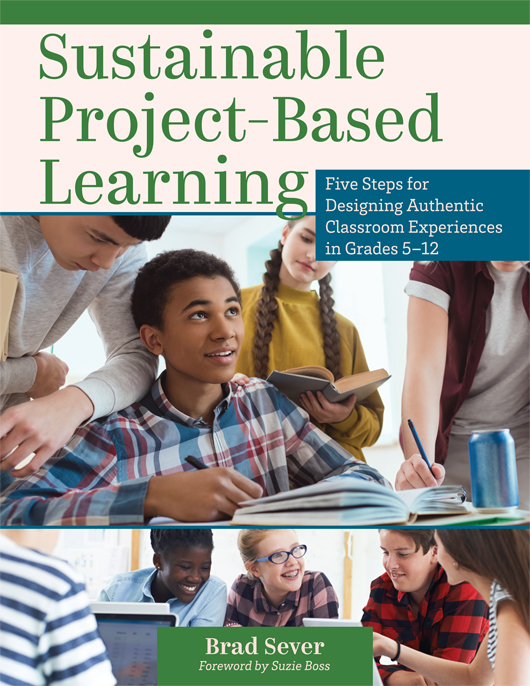Free Reproducibles
Sustainable Project-Based Learning
Five Steps for Designing Authentic Classroom Experiences in Grades 5–12
This essential guide shares a five-step process for designing, implementing, and assessing sustainable project-based learning (SPBL) units while ensuring students gain surface-, deep-, and transfer-level knowledge. Brad Sever draws from his daily work as a practitioner to deliver practical strategies for creating meaningful learning experiences that join academic growth with social-emotional skill development—all supported by the power of professional learning communities.
Benefits
- Learn the benefits of project-based learning (PBL) and social-emotional learning (SEL) to student growth and academic achievement.
- Access a five-step process for planning, integrating, and sustaining a comprehensive SPBL framework in your curriculum.
- Receive reproducible tools and templates you can use independently or collaboratively to maximize student engagement and learning.
- Reflect with end-of-chapter questions to enhance your understanding of the content.
- Understand how to promote transfer learning skills through connections to real-world experiences.
TABLE OF CONTENTS
Part I: The What and Why of Project-Based Learning
Chapter 1: Defining Sustainable Project-Based Learning
Chapter 2: Reviewing the Seven PBL Design Elements
Chapter 3: Maintaining a Sustainable Relationship With Project-Based Learning
Chapter 4: Integrating Social and Emotional Learning Into SPBL Units
Part II: The How of Sustainable Project-Based Learning
Chapter 5: Step 1: Planning the SPBL Unit
Chapter 6: Step 2: Developing SPBL Assessments
Chapter 7: Step 3: Establishing a Clear Goal for Student Learning
Chapter 8: Step 4: Conducting Teacher Action Research
Chapter 9: Step 5: Reflecting, Refining, and Celebrating
Chapter 10: Transferring Learning Through Three Simultaneous Experiences
Appendix A: Glossary of Key Terms
Appendix B: Protocol Library
Appendix C: Example SPBL Unit Plans
REPRODUCIBLES
Chapter 2
- Figure 2.6: Example Milestone Sheet for the Community Relations Director Role
- Figure 2.7: Example Milestone Sheet for the Exhibit Designer and Technology Expert Role
- Figure 2.8: Example Milestone Sheet for the Team Leader Role
- Figure 2.9: Example Milestone Sheet for the Data Analysis Expert Role
- Figure 2.10: Example Milestone Sheet for the Fair-Trade Researcher Role
Chapter 3
Chapter 4
Chapter 5
- Figure 5.2: Checklist for Creating Learning Intentions
- Figure 5.4: Checklist for Developing Success Criteria
- Figure 5.7: Checklist for Crafting the Driving Question
- Figure 5.13: Checklist for Creating Tasks
- Figure 5.15: Checklist for Creating an Entry Event
- Figure 5.17: Checklists for Planning an SPBL Unit
Chapter 6
- Table 6.1: The What and Why of the Four Essential Documents for SPBL Assessment
- Figure 6.2: Checklist for SPBL Culminating Public Product Rubric
- Figure 6.4: Checklist for Summative Assessment for Surface and Deep Learning
- Figure 6.6: Checklist for Anticipated Need-to-Know Map
- Figure 6.8: Checklist for Formative Assessment Calendar
Chapter 7
- Figure 7.1: SPBL SMART Goal Template
- Figure 7.2: Checklist for Establishing a Clear Goal for Student Learning
Chapter 8
- Figure 8.2: Checklist for Conducting Teacher Action Research
- Figure 8.6: Strategies for Creating an Action Research Protocol
Chapter 9
Appendix B
- What? So What? Now What? Protocol
- Examining Student Work Protocol
- Tuning Protocol
- Lesson Study Protocol
- Focused Observation Protocol
- Charrette Protocol
- Inter-Rater Reliability Protocol
- Harkness Discussion Protocol
- Gallery Walk Protocol
- Goal-Setting Protocol
Appendix C
- Example 1: Grade 8 Mathematics
- Example 2: Grade 9 Biology for English Learners
- Example 3: Grades 10–12 Algebra II
- Example 4: Grade 8 Language Arts or Social Studies
- Example 5: Grade 12 Project Lead The Way—Biomedical Innovation (Problem 5: Combating a Public Health Issue)
- Example 6: Grades 11–12 Data Analytics
- Example 7: Grades 11–12 English (AP Literature)
SUGGESTED RESOURCES
BOOKS
- Bayewitz, M. D., Cunningham, S. A., Ianora, J. A., Jones, B., Nielsen, M., Remmert, W., et al. (2020). Help your team: Overcoming common collaborative challenges in a PLC at Work. Bloomington, IN: Solution Tree Press.
- Conzemius, A. E., & O’Neill, J. (2014). The handbook for SMART school teams: Revitalizing best practices for collaboration (2nd ed.). Bloomington, IN: Solution Tree Press.
- DuFour, R. (2004). What is a professional learning community? Educational Leadership, 61(8), 6–11.
- DuFour, R. (2015). In praise of American educators: And how they can become even better. Bloomington, IN: Solution Tree Press.
- DuFour, R., DuFour, R., Eaker, R., & Many, T. W. (2010). Learning by doing: A handbook for Professional Learning Communities at Work (2nd ed.). Bloomington, IN: Solution Tree Press.
- DuFour, R., DuFour, R., Eaker, R., Many, T. W., & Mattos, M. (2016). Learning by doing: A handbook for Professional Learning Communities at Work (3rd ed.). Bloomington, IN: Solution Tree Press.
- Marzano, R. J. (2017). The new art and science of teaching. Bloomington, IN: Solution Tree Press.
- Maxwell, M., Stobaugh, R., & Tassell, J. L. (2016). Real-world learning framework for secondary schools: Digital tools and practical strategies for successful implementation. Bloomington, IN: Solution Tree Press.
- McDowell, M. (2021). Teaching for transfer: A guide for designing learning with real-world application. Bloomington, IN: Solution Tree Press.
- Wiliam, D. (2017). Embedded formative assessment (2nd ed.). Bloomington, IN: Solution Tree Press.
WEBSITES
Chapter 1
Chapter 6


